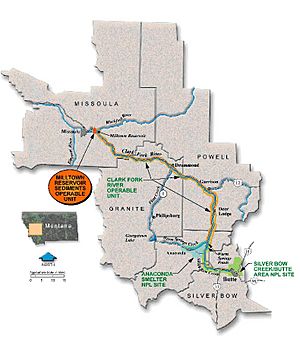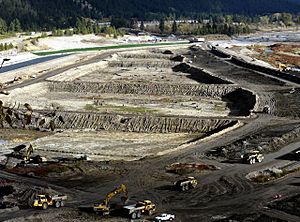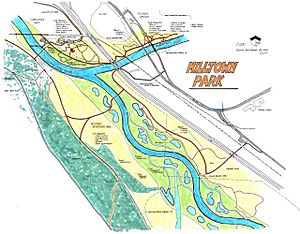Milltown Reservoir Superfund Site facts for kids
The Milltown Reservoir Sediments Superfund Site is a very important cleanup area in Missoula County, Montana. It's about seven miles east of Missoula. This site was added to a special list in 1983. This happened because dangerous arsenic was found in the groundwater near Milltown. The problem started after a huge flood in 1908. This flood washed tons of mining waste into the Clark Fork River. The waste then settled behind the Milltown Dam.
Since 1992, this site has been part of a bigger cleanup effort. It's called the Clark Fork River Superfund Complex. This complex includes three main sites. They are located along 120 miles of the Clark Fork River. The other two sites are near Anaconda and Butte. This complex is the largest and most expensive Superfund site in the United States.
Contents
What is the Milltown Dam Site?
The Milltown Dam (46°52′18″N 113°53′33″W / 46.87167°N 113.89250°W) was a type of dam that made electricity. It was built on the Clark Fork River in western Montana. The dam was about seven miles east of Missoula. It was located where the Blackfoot River joins the Clark Fork.
A rich copper miner named William A. Clark built the dam in 1908. He wanted it to power his sawmills in nearby Bonner. These sawmills made huge wooden beams. These beams were used to support the walls of mine shafts in Butte. Since the 1870s, the Anaconda and Butte areas had very rich copper deposits.
Just a few months after the dam was built, a huge flood happened. This flood washed tons of toxic mining waste downstream. This waste settled at the bottom of the dam. It stayed there for many years. In total, about 6.6 million cubic yards of mud were contaminated. This mud contained arsenic, lead, zinc, copper, and other metals.
Why was it a Superfund Site?
In 1981, a regular water study found a problem. Four wells in Bonner had dangerous heavy metals. These wells supplied water to 35 homes. The Environmental Protection Agency (EPA) and Montana's environmental department closed the wells. They started looking for the cause of the water pollution.
In 1983, they found the reason. The pollution came from heavy metals in the mud. This mud was from many years of mining upstream. The Anaconda Copper Mining Company was responsible. Because of this finding, the Milltown Dam Site was added to the first National Priorities List. This list names the most polluted places needing cleanup.
The EPA immediately began to find out who was responsible. They also started to plan how to fix the groundwater problem. In 1977, the Atlantic Richfield Corporation (ARCO) bought Anaconda Copper. ARCO then became responsible for the damages. Later, in 2000, British Petroleum bought ARCO.
In 1992, local citizens helped make a change. The EPA added more of the Clark Fork River to the Superfund Site. This included the river from the Milltown Dam up to the Warm Springs Ponds. By 1995, the EPA and ARCO finished studying how much the site was polluted. They then tried to figure out how to clean the Milltown groundwater.
However, this study stopped in 1996. A very wet winter caused a large ice jam. This ice jam floated down the Blackfoot River. It crashed into the Milltown Reservoir. This caused a lot of the polluted mud to move. It also killed many fish downstream.
Officials quickly lowered the water level of the reservoir. They were worried about a big release of water and mud. This stopped the ice before it could cause more damage. The EPA immediately checked how bad the damage was. After many public discussions, it was clear. The danger of more polluted mud being released had to be fixed. Over 10,000 people from Western Montana sent comments. They wanted the dam removed and a full cleanup.
In 2003, the State of Montana made a plan. This plan was for restoring the Milltown Dam site. In December 2004, the EPA released its final cleanup plan. It called for removing over two million cubic yards of polluted mud. It also called for removing the Milltown Dam. In August 2005, the groups involved signed an agreement. This allowed the project to start. After more than 20 years of studies and legal talks, work began on June 1, 2006. The first step was lowering the Milltown Reservoir. The polluted mud was taken to a special storage area. This area was near the town of Opportunity. Some local people did not agree with this decision.
The Three R's of the Superfund Project
The Milltown Superfund project had three main goals. These are called the "Three R's": Remediation, Restoration, and Redevelopment.
What is Remediation?
Remediation means cleaning up dangerous substances. This is done to protect people's health and the environment. The EPA and its main contractor, Envirocon, led the cleanup at Milltown. This phase included removing three million tons of polluted mud. It also involved taking out the Milltown Dam itself.
The goals of remediation were important. They included cleaning the Milltown Aquifer. This is the underground water source. They also aimed to improve the water quality downriver. Another goal was to help the trout fish population grow again. Work started in the summer of 2006. The cleanup phase finished by December 2009. After that, the State of Montana took over. They began the next phase, which was restoration.
What is Restoration?
Restoration at Milltown meant creating a natural river and floodplain. This happened after the dam and mud were removed. The State of Montana led this restoration work. They used money from a lawsuit against ARCO. Their goal was to return the area where the rivers met to a natural state.
Restoration work began in summer 2008. It sped up as the mud removal finished. This work included shaping a new river channel. It also involved creating wetlands near the river. They also strengthened the river banks. And they replanted natural plants. The restoration work was planned to be finished by 2012.
What is Redevelopment?
Redevelopment means making former hazardous waste sites useful again. The plan for the Milltown area was to create a state park. This park would have trails. These trails would connect nearby communities.
In 2007, a design for the park was made. Many groups worked together on this. These included the Milltown Superfund Redevelopment Working Group. Also involved were the Montana Department of Fish, Wildlife, and Parks. The National Park Service Rivers and Trails Program helped too. In 2009, a request for money was sent in. This money would help start building the park.
Images for kids








